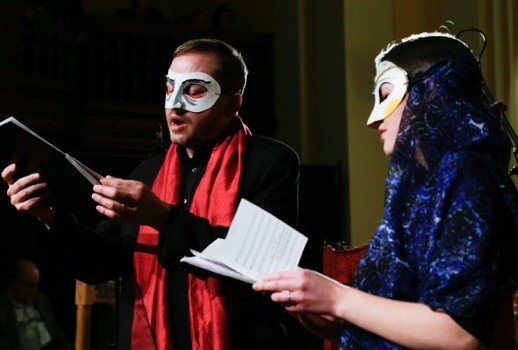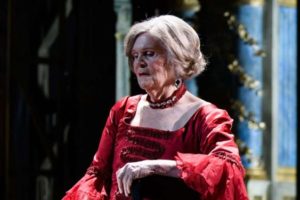

The title is an unhappy choice because, though it pricks the attention of any opera-lover and sets the story in its time and place, such a title gets us humming Verdi and Mozart, and the work being presented cannot compete on that level. Best to leave the masters out of it, and you can enjoy a charming pasticcio of Turkish folk music played on original instruments interleaved with Italian madrigals.
The story, derived from a Turkish novel of 1933, concerns one of the “black eunuchs,” enslaved and marched across the Sahara, assigned to the harem of the sultans in Istanbul, a custom that continued as long as the Ottoman monarchy. One of these eunuchs, Sümbül, rich and retired after a long career, buys an Italian slave girl, Suzun (remember those Turkish corsairs who keep turning up in operas? They were real), as a gift to his old master, the sultan.
But the girl is damaged goods! Pregnant by one of the pirates. That won’t do for the sultan, so he keeps her himself and treats her kindly. They fall in love. They even marry.
This outrages another European slave, Frenk Mustafa (Mustafa the European), who believes he has more right to the girl (being whole) than does a eunuch. Suzun spurns him, so he becomes Iago, playing on Sümbül’s jealousy and fears of inadequacy, driving him to murder the girl. A Turkish maid tells Sümbül the truth and he kills himself. Suzun’s son inherits the house, and the title “Bastard of the Chief Black Eunuch.”
You can see the operatic potential of this tale, but grand opera was not the intention or, perhaps, the talent of the composer, Mehmet Ali Sanl?kol. Sanlikol, master of a dozen traditional Turkish instruments (kemane, kasuk, ceng, ud, ney, zurna, nekkare, davul, darbuka, bombo and kos—and do try the mezes!) which, as well as many western ones (gamba, recorders, sackbut), are part of the Dünya ensemble, has attempted to tell a story of clashing cultures by clashing and blending their different musics.
This is a method that has evolved in many Dünya recordings that present linkages between the music of ancient Byzantium and medieval Istanbul, including all the cultures under the Ottoman regime. This is rather in the manner of the programs of Jordi Savall, from the other end of the Mediterranean, who produces similar albums of Moorish, Crusader, Troubadour and Greek Orthodox traditions, blended and displayed.
In Othello in the Seraglio, therefore, Sümbül (Sanlikol himself) sings traditional Turkish laments of love, with Middle Eastern melismas and ornamentation and some falsetto flutters for the eunuch’s keening; Suzun (soprano Camila Parias) sings Italian madrigals of Monteverdi and his ilk with a sweet, true voice and the bleating trills of that day; Frenk Mustafa (baritone Michael Barrett) sings an insidious “crossover” between the cultures, and Saadet, the maid (alto Burcu Gülec) performs Turkish music with finger cymbals and ecstatic ululations. The music-making was fine and haunting, the alternation of styles and languages and rhythms keeping the occasion vivid.
There was even an a cappella quartet, perhaps another nod to Verdi’s and Mozart’s operas, but this appeared to be more of the meditative variety, each character making a statement to us of private feelings than the interactive quartets of Otello and Seraglio. But it’s certainly where Sanlikol should begin if he really wants to create Turkish folk opera, a praiseworthy ambition.
There were no surtitles and I did not miss them, in part because Ms. Parias’ Italian lyrics were comprehensible to any opera lover, but also because of the “coffeehouse opera” concept, developed by Robert Labaree and directed by Brian Fairley, who collaborated on the script.
Storytelling in the coffeehouses is an Ottoman tradition: Max Sklar played a garrulous narrator, telling us everything we might to know (and then some) to know about the characters, their motivations and the customs of old Istanbul. The original storytellers also panhandled the audience between numbers, as in Massenet’s Le Jongleur de Notre Dame.
Thus the story was clear enough, but the conceit let the composer off the hook: He did not have to make an opera out of it, have his persons evolve and interact. The “opera” consisted of alternating numbers and lengthy verbal footnotes. There were statements of character and motivation, but the singers never became those characters, never felt those motivations. It was an action with very little action.
National Sawdust, on North Seventh Street, is a venue new to me, including restaurant, bar and performance spaces. The room for the opera is about half the size of Merkin Hall at Lincoln Center and boasts superb acoustics, no doubt enhanced by the décor, which is sort of a modern, asymmetrical take on traditional, symmetrical Moorish motifs. Very appropriate to this piece. They do a lot of fascinating classical avant-garde stuff, but I’d also recommend it to anyone looking for a concert venue in Brooklyn.
Photography: Öykü Canli
























Comments